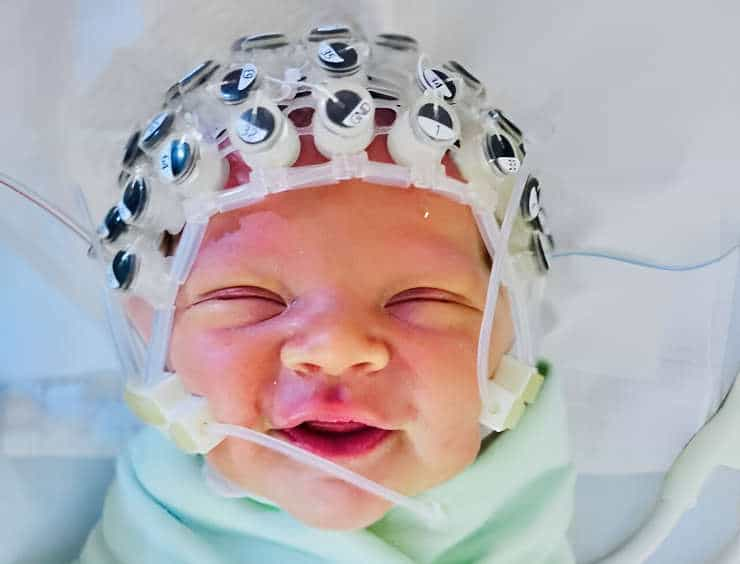According to new research, newborn newborns can detect the beat in music. Researchers from the University of Amsterdam and the HUN-REN Research Center for Natural Sciences (TTK) in Hungary found that beat perception is a distinct cognitive mechanism that is already active at birth, not just due to newborns’ statistical learning ability.
“There is still a lot we don’t know about how newborn babies perceive, remember and process music. But, in 2009, we found clear indications that babies of just a few days old have the ability to hear a regular pulse in music — the beat — a characteristic that is considered essential for making and appreciating music, “
says author Henkjan Honing, professor of Music Cognition at the UvA.
Because Honing and his colleagues’ prior study had so far remained unreplicated and they still had many questions, the UvA and TTK teamed up once more — this time utilizing a new paradigm. Researchers altered the timing of drum rhythms in an experiment with 27 newborn newborns to discover if babies distinguish between learning the order of sounds in a drum rhythm (statistical learning) and being able to recognize a beat (beat-induction).
Jittered Beat Learning

Through headphones, the newborns were exposed to two different versions of the same drum rhythm. The timing was isochronous in the initial version: the spacing between the sounds was always the same. This allows someone to hear a pulse or beat in the rhythm.
The identical drum pattern was shown in the other version, but with irregular time (jittered).
As a result, beat perception was not possible, but the sequence of sounds could be learnt. This enabled the researchers to distinguish between beat perception and statistical learning.
Because behavioral responses in newborn babies cannot be observed, the research was done with brain wave measurements (EEG) while the babies were sleeping. This way, the researchers were able to view the brain responses of the babies.
These responses demonstrated that the babies heard the beat when the time interval between beats was constant. The babies did not hear a beat when the researchers played the identical pattern at unpredictable time intervals.
Infant Cognition and Musical Skill
This significant distinction demonstrates that the ability to perceive rhythm is intrinsic rather than the product of taught sound patterns.
“Our findings suggest that it is a specific skill of newborns and make clear how important baby and nursery rhymes are for the auditory development of young children. More insight into early perception is of great importance for learning more about infant cognition and the role that musical skills may play in early development,
said co-author István Winkler, professor at the Institute of Cognitive Neuroscience and Psychology at TTK.
“Most people can easily pick up the beat in music and judge whether the music is getting faster or slower—it seems like an inconsequential skill. However, since perceiving regularity in music is what allows us to dance and make music together, it is not a trivial phenomenon. In fact, beat perception can be considered a fundamental human trait that must have played a crucial role in the evolution of our capacity for music,”
Honing added.
Abstract
Newborn infants have been shown to extract temporal regularities from sound sequences, both in the form of learning regular sequential properties, and extracting periodicity in the input, commonly referred to as a regular pulse or the ‘beat’. However, these two types of regularities are often indistinguishable in isochronous sequences, as both statistical learning and beat perception can be elicited by the regular alternation of accented and unaccented sounds. Here, we manipulated the isochrony of sound sequences in order to disentangle statistical learning from beat perception in sleeping newborn infants in an EEG experiment, as previously done in adults and macaque monkeys. We used a binary accented sequence that induces a beat when presented with isochronous timing, but not when presented with randomly jittered timing. We compared mismatch responses to infrequent deviants falling on either accented or unaccented (i.e., odd and even) positions. Results showed a clear difference between metrical positions in the isochronous sequence, but not in the equivalent jittered sequence. This suggests that beat processing is present in newborns. Despite previous evidence for statistical learning in newborns the effects of this ability were not detected in the jittered condition. These results show that statistical learning by itself does not fully explain beat processing in newborn infants.
Reference:
- Gábor P. Háden et al. Beat processing in newborn infants cannot be explained by statistical learning based on transition probabilities. Cognition (2023). DOI: 10.1016/j.cognition.2023.105670
